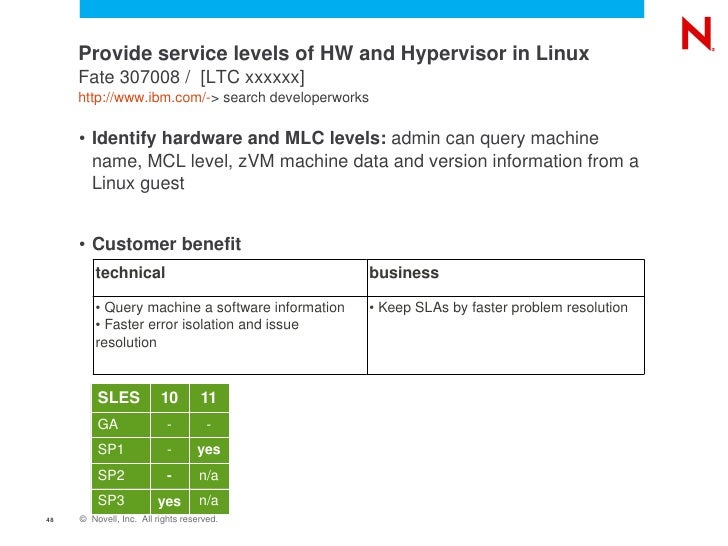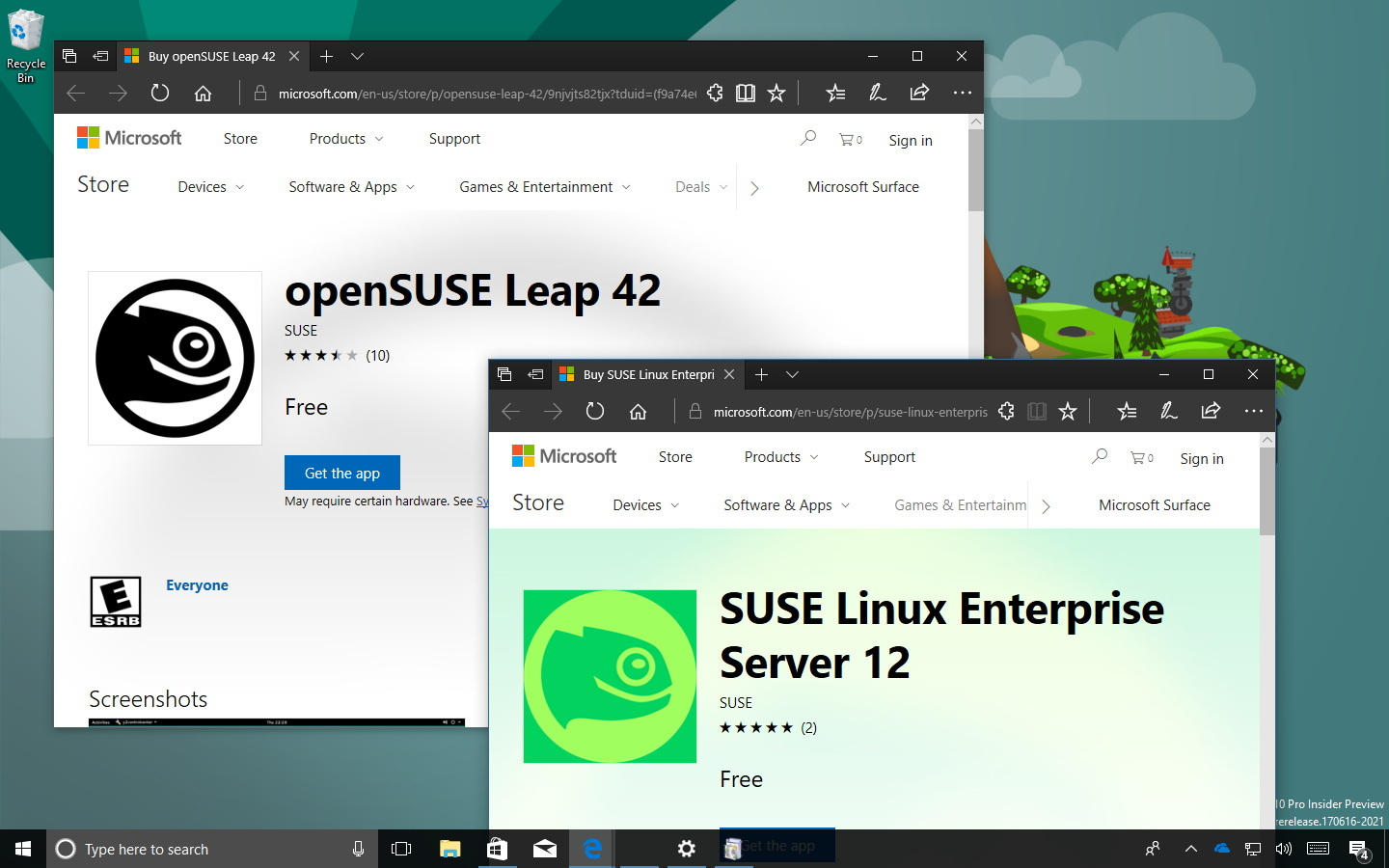Get #1-rated Linux support and save up to 50% when you standardize on SUSE Linux Enterprise with Expanded Support. SUSE Linux Enterprise is supported on all major server & desktop hardware. Free trials—180 days for z Systems. Get the latest generation of Enterprise Linux OS with the reliability of. OpenSUSE Tumbleweed is a rolling-release. This means the software is always the latest stable versions available from the openSUSE Project. Things will change regularly as Free and Open Source projects continually release new versions of their software. Tumbleweed is recommended for Developers, openSUSE Contributors, and Linux/FOSS Enthusiasts.
Applies To: Windows Server 2016, Hyper-V Server 2016, Windows Server 2012 R2, Hyper-V Server 2012 R2, Windows Server 2012, Hyper-V Server 2012, Windows Server 2008 R2, Windows 10, Windows 8.1, Windows 8, Windows 7.1, Windows 7

The following is a feature distribution map that indicates the features in each version. The known issues and workarounds for each distribution are listed after the table.

The built-in SUSE Linux Enterprise Service drivers for Hyper-V are certified by SUSE. An example configuration can be viewed in this bulletin: SUSE YES Certification Bulletin.

Table legend
Built in - LIS are included as part of this Linux distribution.The Microsoft-provided LIS download package does not work for this distribution, so do not install it.The kernel module version numbers for the built in LIS (as shown by lsmod, for example) are different from the version number on the Microsoft-provided LIS download package. A mismatch doesn't indicate that the built in LIS is out of date.
✔ - Feature available
(blank) - Feature not available
SLES12+ is 64-bit only.
| Feature | Windows Server operating system version | SLES 15 | SLES 12 SP3/SP4 | SLES 12 SP2 | SLES 12 SP1 | SLES 11 SP4 | SLES 11 SP3 |
|---|---|---|---|---|---|---|---|
| Availability | Built-in | Built-in | Built-in | Built-in | Built-in | Built-in | |
| Core | 2019, 2016, 2012 R2, 2012, 2008 R2 | ✔ | ✔ | ✔ | ✔ | ✔ | ✔ |
| Windows Server 2016 Accurate Time | 2019, 2016 | ✔ | ✔ | ✔ | |||
| Networking | |||||||
| Jumbo frames | 2019, 2016, 2012 R2, 2012, 2008 R2 | ✔ | ✔ | ✔ | ✔ | ✔ | ✔ |
| VLAN tagging and trunking | 2019, 2016, 2012 R2, 2012, 2008 R2 | ✔ | ✔ | ✔ | ✔ | ✔ | ✔ |
| Live migration | 2019, 2016, 2012 R2, 2012, 2008 R2 | ✔ | ✔ | ✔ | ✔ | ✔ | ✔ |
| Static IP Injection | 2019, 2016, 2012 R2, 2012 | ✔Note 1 | ✔Note 1 | ✔Note 1 | ✔Note 1 | ✔Note 1 | ✔Note 1 |
| vRSS | 2019, 2016, 2012 R2 | ✔ | ✔ | ✔ | ✔ | ||
| TCP Segmentation and Checksum Offloads | 2019, 2016, 2012 R2, 2012, 2008 R2 | ✔ | ✔ | ✔ | ✔ | ✔ | |
| SR-IOV | 2019, 2016 | ✔ | ✔ | ✔ | |||
| Storage | |||||||
| VHDX resize | 2019, 2016, 2012 R2 | ✔ | ✔ | ✔ | ✔ | ✔ | ✔ |
| Virtual Fibre Channel | 2019, 2016, 2012 R2 | ✔ | ✔ | ✔ | ✔ | ✔ | ✔ |
| Live virtual machine backup | 2019, 2016, 2012 R2 | ✔ Note 2, 3, 8 | ✔ Note 2, 3, 8 | ✔ Note 2, 3, 8 | ✔ Note 2, 3, 8 | ✔ Note 2, 3, 8 | ✔ Note 2, 3, 8 |
| TRIM support | 2019, 2016, 2012 R2 | ✔ | ✔ | ✔ | ✔ | ✔ | |
| SCSI WWN | 2019, 2016, 2012 R2 | ✔ | ✔ | ✔ | |||
| Memory | |||||||
| PAE Kernel Support | 2019, 2016, 2012 R2, 2012, 2008 R2 | N/A | N/A | N/A | N/A | ✔ | ✔ |
| Configuration of MMIO gap | 2019, 2016, 2012 R2 | ✔ | ✔ | ✔ | ✔ | ✔ | ✔ |
| Dynamic Memory - Hot-Add | 2019, 2016, 2012 R2, 2012 | ✔ Note 5, 6 | ✔ Note 5, 6 | ✔ Note 5, 6 | ✔ Note 5, 6 | ✔ Note 4, 5, 6 | ✔ Note 4, 5, 6 |
| Dynamic Memory - Ballooning | 2019, 2016, 2012 R2, 2012 | ✔ Note 5, 6 | ✔ Note 5, 6 | ✔ Note 5, 6 | ✔ Note 5, 6 | ✔ Note 4, 5, 6 | ✔ Note 4, 5, 6 |
| Runtime Memory Resize | 2019, 2016 | ✔ Note 5, 6 | ✔ Note 5, 6 | ✔ Note 5, 6 | |||
| Video | |||||||
| Hyper-V-specific video device | 2019, 2016, 2012 R2, 2012, 2008 R2 | ✔ | ✔ | ✔ | ✔ | ✔ | ✔ |
| Miscellaneous | |||||||
| Key/value pair | 2019, 2016, 2012 R2, 2012, 2008 R2 | ✔ | ✔ | ✔ | ✔ | ✔ Note 7 | ✔ Note 7 |
| Non-Maskable Interrupt | 2019, 2016, 2012 R2 | ✔ | ✔ | ✔ | ✔ | ✔ | ✔ |
| File copy from host to guest | 2019, 2016, 2012 R2 | ✔ | ✔ | ✔ | ✔ | ✔ | |
| lsvmbus command | 2019, 2016, 2012 R2, 2012, 2008 R2 | ✔ | ✔ | ✔ | |||
| Hyper-V Sockets | 2019, 2016 | ✔ | ✔ | ||||
| PCI Passthrough/DDA | 2019, 2016 | ✔ | ✔ | ✔ | ✔ | ||
| Generation 2 virtual machines | |||||||
| Boot using UEFI | 2019, 2016, 2012 R2 | ✔ Note 9 | ✔ Note 9 | ✔ Note 9 | ✔ Note 9 | ✔ Note 9 | |
| Secure boot | 2019, 2016 | ✔ | ✔ | ✔ | ✔ |
Notes
Static IP injection may not work if Network Manager has been configured for a given Hyper-V-specific network adapter on the virtual machine. To ensure smooth functioning of static IP injection please ensure that Network Manager is turned off completely or has been turned off for a specific network adapter through its ifcfg-ethX file.
If there are open file handles during a live virtual machine backup operation, then in some corner cases, the backed-up VHDs might have to undergo a file system consistency check (fsck) on restore.
Live backup operations can fail silently if the virtual machine has an attached iSCSI device or direct-attached storage (also known as a pass-through disk).
Dynamic memory operations can fail if the guest operating system is running too low on memory. The following are some best practices:
Startup memory and minimal memory should be equal to or greater than the amount of memory that the distribution vendor recommends.
Applications that tend to consume the entire available memory on a system are limited to consuming up to 80 percent of available RAM.
Dynamic memory support is only available on 64-bit virtual machines.
If you are using Dynamic Memory on Windows Server 2016 or Windows Server 2012 operating systems, specify Startup memory, Minimum memory, and Maximum memory parameters in multiples of 128 megabytes (MB). Failure to do so can lead to Hot-Add failures, and you may not see any memory increase in a guest operating system.
In Windows Server 2016 or Windows Server 2012 R2, the key/value pair infrastructure might not function correctly without a Linux software update. Contact your distribution vendor to obtain the software update in case you see problems with this feature.
VSS backup will fail if a single partition is mounted multiple times.
On Windows Server 2012 R2, Generation 2 virtual machines have secure boot enabled by default and Generation 2 Linux virtual machines will not boot unless the secure boot option is disabled. You can disable secure boot in the Firmware section of the settings for the virtual machine in Hyper-V Manager or you can disable it using Powershell: